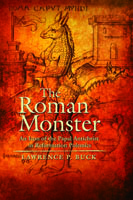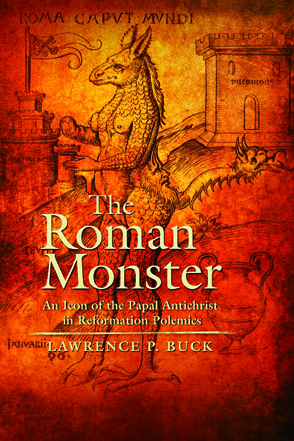The Roman Monster
An Icon of the Papal Antichrist In Reformation Polemics
Lawrence Buck
“Of all the curious, horrifying cast of monstrous characters known to early-modern Europeans, the Papal Ass was certainly one of the strangest. Word of its “dredging up” from the River Tiber in 1496 traveled a circuitous route through sixteenth-century Europe, helping to make the famous images that Cranach and others fashioned to depict it into readily recognizable pieces of the era’s mental furniture. Lawrence Buck’s dogged attempts to cast light upon the trail that knowledge and exploitation of this event followed reveals a great deal about the ways in which religious, scientific, and preternatural knowledge got around in pre-modern society.”
- Description
- Reviews
- Bio
- Table of Contents
This study examines the iconography of the image of the Roman monster and offers ideological reasons for associating the image with the pre-Reformation Waldensians and Bohemian Brethren. It accounts for the reproduction and survival of the monster's image in fifteenth-century Bohemia and provides historical background on the topos of the papal Antichrist, a concept that Philip Melanchthon associated with the monster. It contextualizes Melanchthon’s tract, “The Pope-Ass Explained,” within the first five years of the Lutheran movement, and it documents the popularity of the Roman monster within the polemical and apocalyptic writings of the Reformation.
This is a careful examination and interpretation of all relevant primary documents and secondary historical literature in telling the story of the origins and impact of the most famous monstrous portent of the Reformation era.
“Of all the curious, horrifying cast of monstrous characters known to early-modern Europeans, the Papal Ass was certainly one of the strangest. Word of its “dredging up” from the River Tiber in 1496 traveled a circuitous route through sixteenth-century Europe, helping to make the famous images that Cranach and others fashioned to depict it into readily recognizable pieces of the era’s mental furniture. Lawrence Buck’s dogged attempts to cast light upon the trail that knowledge and exploitation of this event followed reveals a great deal about the ways in which religious, scientific, and preternatural knowledge got around in pre-modern society.”
“This book is a fascinating and meticulous study of antipapal polemics from the early Reformation to the Elizabethan religious settlement. Lawrence Buck skillfully analyzes the iconography of the various images of a grotesque monstrosity that had been discovered after the Tiber River flooded Rome, and traces the uses they were put to by reformers including Philip Melanchthon’s 1523 pamphlet, “The Pope-Ass Explained.” With abundant illustrations, Buck’s monograph delineates the various elements used to illustrate the monster and its connection to the papal antichrist. Buck also ties the Roman Monster into the discourse of the Reformation including Luther’s use of it, its appearance in Wonder-book literature, its use in polemics as part of the French Wars of Religion and the Elizabethan Reformation. This intriguing book should attract widespread interest from Reformation scholars. It is one of the freshest and most original books to have appeared in several years.”
“... meticulously uncovers the origin of the stores... The detective work demonstrated in this section is to be lauded ...Masterfully and deftly, Buck finally has given us the answers...”
“Throughout, Buck displays fluency across a number of topics, from the relationships between groups of late medieval dissenters to the polemics of the Lutheran Reformation.”
“The Roman Monster is a significant new addition to scholarly work on Reformation propaganda.”
“Through the history of an image of great polemical power, interpreted metaphorically and eschatologically, the author traces the continuing diffusion of the Roman monster in antipapal criticism intrinsic in Protestant fervor.”
“The volume interweaves both the medieval backgrounds and the relevant narrative of the Protestant Reformation, rendering it accessible to the non-specialist. For the specialists, it offers an important glimpse of how Reformation polemic availed itself of visual images and why those symbols resonated with people.”
“This is a very good book, and the work Buck has done to trace the early history of the image is impressive…It is well illustrated and rounded out with a translation of Melanchthon’s 1523 text.”
Lawrence Buck is professor emeritus of history at Widener University. After serving as provost and academic vice president for twenty years at Widener, he returned to full-time teaching from 2004 to 2013. He co-edited The Social History of the Reformation, a festschrift in honor of Professor Harold Grimm, and translated Monemvasia: The Town and its History. He received his PhD from Ohio State University.
Illustrations
Acknowledgments
Abbreviations
Introduction: The Roman Monster: Historical Context
Chapter 1: The Roman Monster of 1496
From Pious Portent to Political Pasquinade
The Roman Flood, 1495/96
Iconographic Meaning of the Ass
Iconography of Papal Authority
The Donation of Constantine
The Waldensians
The Bohemian Brethren
Chapter 2: The Roman Monster in the Kingdom of Bohemia 1498–1523
The Waldensians and Bohemian Brethren in the Kingdom of Bohemia
Persecution of the Bohemian Brethren
Wenzel von Olmütz’s Reproduction of the Roman Monster
Luther Receives the Roman Monster Illustration
Chapter 3: The Papal Antichrist
The Received Tradition: Abbot Adso
Joachim of Fiore and the Joachimites
The Papal-Franciscan Controversy
John Wyclif
The Czech Reform—The Collective Antichrist
The Antichrist Antitheses
The Anatomy of the Antichrist
Recapitulation
Chapter 4: Philip Melanchthon’s The Pope-Ass Explained (1523)
Reformation Narrative to 1523
The Leipzig Disputation of 1519
Luther and the Papal Antichrist
The Publication of The Pope-Ass Explained
The Pope-Ass Explained: An Explication of the Text
The Animalized Monstrosity of the Papal Antichrist
Conclusion
Chapter 5: The Diffusion of the Roman Monster within the Discourse of the Reformation
Editions and Translations of The Pope-Ass Explained
Luther’s Vocabulary of Asininity
The Roman Monster in Wonder-Book Literature
The Roman Monster in the Polemics of the French Wars of Religion
The Roman Monster in the Elizabethan Reformation: The Pedegrewe of Heretiques
The Roman Monster in the Elizabethan Reformation: Of two VVoonderful Popish Monsters: A Declaration of the Monstrous figure of a Popish Asse
Conclusion: The Pope-Ass as a Trope of Antipapalism in Reformation Politics
Appendix: The Pope-Ass Explained (1523) by Philip Melanchthon
Bibliography
Index
Mailing List
Subscribe to our mailing list and be notified about new titles, journals and catalogs.




